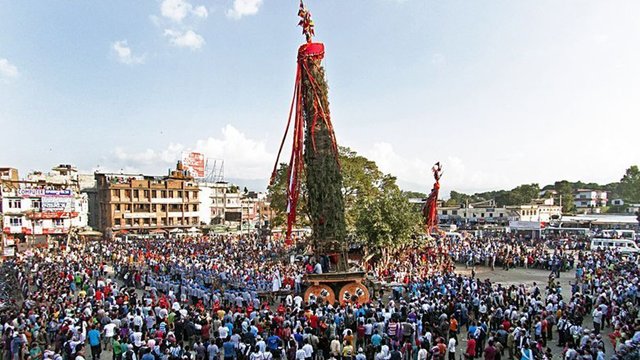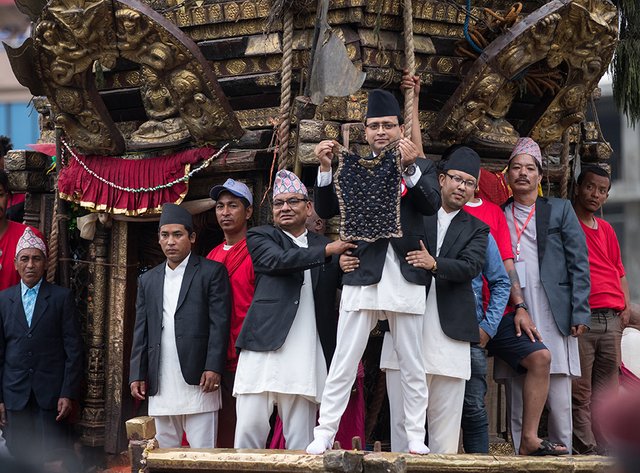Bhoto jatra Festival

Before we begin the story, you might want to know what a “Bhoto” is, yes. Well, it’s a vest. “Bhoto” in Nepali translates to “a vest”. “Jatra” means “Festival”. And so, you will read the story of the festival of devolve. Yes, you read that correctly, we have a festival for a devolve here, and it’s remarkable.
Bhoto Jatra ends the month-long merriment of Rato Machhendranath Jatra. (Now, this is a story for another time). Rato Machhendranath is a god and The God of Rain. Every year, the huge Chariot of Rato Machhendranath is pulled around the valley, and when I say huge, it really is huge with a 60-feet tall point above the chariot connected to it from all four ends, fabricated from bamboo poles
Long back, in Kathmandu valley, there was a lake named Taudaha. In the lake lived the king of all snakes, a half-snake half-man God named Karkotak. This story begins with an sickness Karkotak’s wife had one day. She complained to her husband about her eye paining. So, in order to freed his beloved wife of the sickness, Karkotak began his journey to Bhaktapur, to visit a witchdoctor, who also happened to be a farmer. Reaching him, Karkotak requested, “O Witchdoctor! Come with me to my palace, my wife’s eye is in pain and I need you to fix it. I promise you will be rewarded attractively for your services”. The witchdoctor approved and went with Karkotak back to Taudaha Lake. Upon arriving, Karkotak caught hold of the witchdoctor farmer and jumped into the lake, and with his godly powers, made the mortal able to breathe underwater. They arrived at the luxurious palace, and the witchdoctor began to work on the queen’s eye. With medication, he was able to rid the queen of her sickness.

The farmer wore that Bhoto everywhere he went, which caught the eyes of everybody in the valley. And when I say everybody, I mean everybody. A ghost saw the farmer wearing the Bhoto and he began to turn green with jealousy. Without the farmer noting, the ghost began to shadow him everywhere and his actions proved rewarding when one day, the farmer put apart his diamond encrusted Bhoto to work on his farm. Seizing this opportunity, the ghost stole the Bhoto and ran away.
“Hay! Come back here!! That’s mine!” sobbed the farmer as he rushed after the ghost. The lights from the diamond shone off and made the ghost noticeable for a few seconds before he disappeared again. The farmer was then left chasing the sudden komerabi of light that was given off by the diamonds, but no matter how hard he tried, the farmer could not seem to catch the ghost.
The sun went down, and twilight came. Running all over town after the ghost, the farmer came across the wide planes of Bhaktapur, where the festival of the Red Rain God, Machhendranath, was going on in full swing with people pulling the giant chariot to a stop there. “The whole valley is here, celebrating, and so, the ghost must also be here somewhere”, thought the farmer. Just then, as he managed to finish this thought, he caught sight of the light from the diamonds being reflected by the last dying sun. Sneeringly, very quietly and discreetly, he sneaked behind the ghost who was indeed watching the festival itself, and caught hold of him, tight.
“Give me back my Bhoto!” demanded the farmer. “NO!” screamed the ghost. And thus, an argument ensured.
Coincidently, the chariot of King Gunkampdev was being driven there; the king had come to watch the festival. The guards of the king got hold of the arguing farmer and the ghost and presented them before the king. “They were disturbing the peace here”, they said.
Now, King Gunkampdev was a fair and just king, and wanted to know both sides of the story. The farmer went first, “Your majesty, this is my Bhoto. This imbecile ghost stole it away from me while I kept it aside to work on my farm. This Bhoto is a reward I got from the snake-king Karkotak for helping his ailing wife. This is my Bhoto!” said the farmer.
Then, the ghost spoke, “Your Excellency, he is lying. This Bhoto is mine. I found it on the side of a road, discarded and unused and so I took it. Its mine!”
Listening to both sides of the story, the kind made a decision. “The proprietorship of this Bhoto shall be with the priests of the Machhendranath chariot until either of you can show me some concrete proof of the Bhoto belonging to either of you”.
And thus, the farmer went back to Taudaha Lake to confront Karkotak the Snake-king about everything that went down. He requested the snake-king to come back with him as a witness and to provide the proof the king wanted.
“Alright, I will come as your witness. Be on the look-out for me. There is going to be a storm when I arrive. Also, I will be taller than the rest of the people there”, said Karkotak. The farmer went back to the festival and waited there for three days. At the end of the third day, people were starting to go back home. The festival was coming to a close. Try as he might, the framer could not locate the snake-king among the crowd. The wind blew a bit more furiously, but there was no storm. And so, the priest at the Machhendranath chariot displayed the Bhoto to the crowd a final time during the festival. “Who does this Bhoto belong to?” he asked the crowd, displaying it from all the four corners of the chariot. “Who does this Bhoto belong to?”
But none came forward with any proof. And so, the tradition of Bhoto Jatra began, with the displaying of the Bhoto like this to the crowd every year, the priests waiting for someone to come forth and claim the Bhoto with concrete proof that it does belong.
Congratulations @ashishfromnepal! You received a personal award!
You can view your badges on your Steem Board and compare to others on the Steem Ranking
Vote for @Steemitboard as a witness to get one more award and increased upvotes!